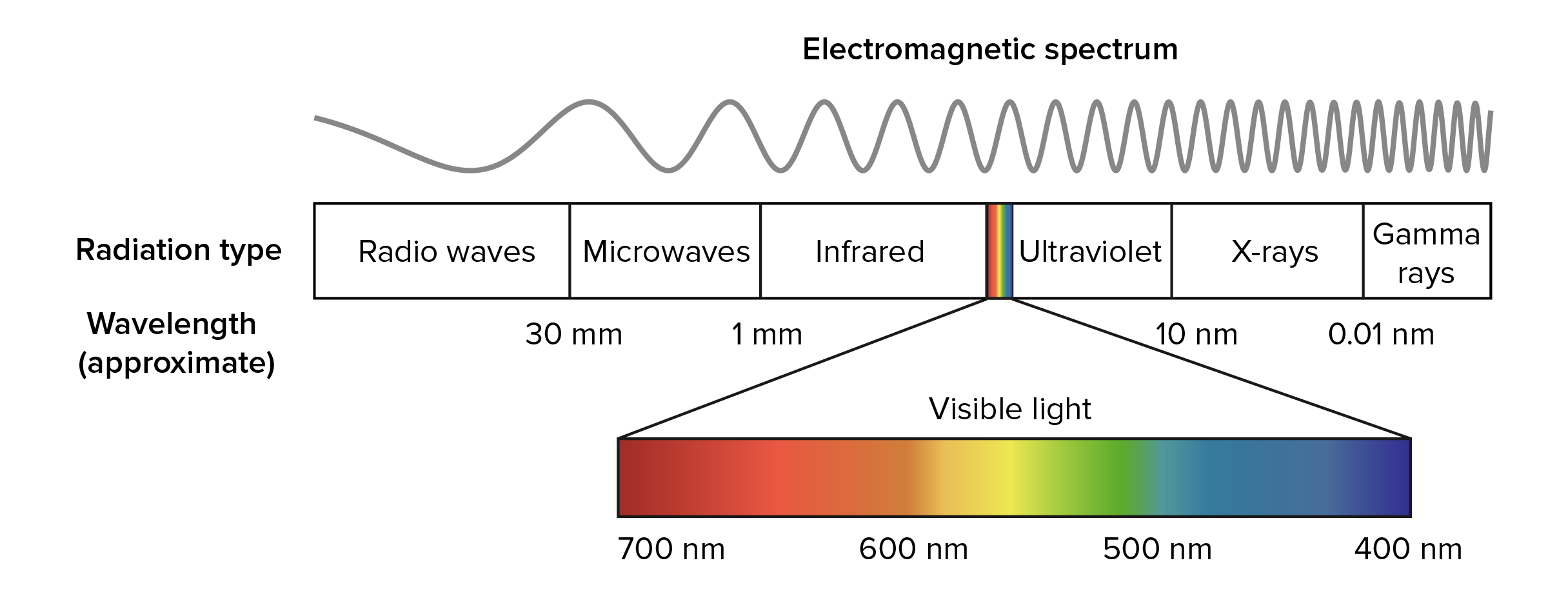Have you ever wondered why the sky appears blue during the day and turns a fiery orange during sunset? Or why a red light seems to penetrate fog better than a blue light? These captivating phenomena are governed by the fascinating world of light, specifically the invisible spectrum of colors that make up our visual experience. And within this diverse spectrum lies a fundamental property known as wavelength, which dictates the color we perceive.

Image: socratic.org
So, which color of light has the longest wavelength? It’s red, the color we associate with passion, warmth, and energy. This might seem counterintuitive at first, as red often symbolizes intensity and heat, while blue is often associated with calmness and coolness. But delve deeper into the science of light, and you’ll uncover the reason why red reigns supreme in the realm of wavelength.
Unveiling the Rainbow: A Journey into the Electromagnetic Spectrum
Imagine a vast ocean, its surface shimmering with countless waves. This ocean isn’t made of water, but of electromagnetic radiation, an invisible force that carries energy through space. Within this vast ocean, light is just one ripple, and it dances in a spectrum of colors, each with its own unique frequency and wavelength.
Wavelength, simply put, is the distance between two consecutive crests or troughs of a wave. Imagine a rollercoaster track; the wavelength is the distance between two successive peaks. The shorter the wavelength, the more energy the wave carries, and the higher its frequency. And as we traverse the rainbow, we move from shorter wavelengths (violet) to longer wavelengths (red).
Violet, the color of royalty and mystery, holds the shortest wavelength, vibrating with the highest frequency. Its energy is so potent that it can even break apart molecules, contributing to the power of ultraviolet light. On the other end of the spectrum, red, with its longer wavelength and lower frequency, might seem gentler, but it still carries its own unique power. Its longer wavelength allows it to penetrate fog and mist more effectively than shorter wavelengths, which is why red lights are often used in emergency vehicles and traffic signals.
A Spectrum of Possibilities: Real-World Applications
The understanding of light’s wavelength isn’t just a theoretical exercise. It has profound implications for various technologies and industries, impacting our daily lives in countless ways.
Medical Imaging: Infrared light with its longer wavelength can penetrate tissues deeper than visible light, allowing doctors to see inside the body without resorting to invasive procedures. This technology is used in thermal imaging for early cancer detection, monitoring blood flow, and identifying potential infections.
Communication: Fiber optic cables rely on light to transmit data at incredible speeds. Specifically, infrared light, with its longer wavelength, is preferred for fiber optic communication, as it experiences less signal loss during transmission, ensuring smoother and more efficient data flow.
Astronomy: By studying the wavelengths of light emitted from distant stars and galaxies, astronomers gain insights into their composition, temperature, and even their movement across the vast expanse of space. From the faint glow of red giants to the brilliant blue hues of young, hot stars, each wavelength reveals a different aspect of our celestial neighbors.
Photography: Photographers utilize specialized filters that selectively block certain wavelengths to create specific effects. Color filters, for example, can enhance certain colors or create a dramatic mood, while infrared filters reveal hidden details invisible to the naked eye.
Beyond the Rainbow: The Wonders of Infrared and Beyond
The visible spectrum that we see with our eyes is only a tiny sliver of the vast electromagnetic spectrum. Beyond the red end lies the realm of infrared radiation, with even longer wavelengths that we cannot see but can feel as heat. This invisible light is used in countless applications, from night vision goggles to remote controls for our TVs.
Moving further down the spectrum, we encounter microwaves, which are used for cooking, satellite communication, and even radar. And beyond microwaves lie the radio waves with the longest wavelengths, enabling us to listen to our favorite tunes, communicate over long distances, and even study distant celestial objects.

Image: www.animalia-life.club
Which Color Of Light Has The Longest Wavelength
Embracing the Spectrum of Knowledge: A Call to Action
The journey through the electromagnetic spectrum is an awe-inspiring exploration, revealing the intricate workings of nature and the power of scientific understanding. Whether it’s the breathtaking colors of a sunset or the invisible forces that power our modern world, light, with its diverse wavelengths, plays a crucial role in shaping our perception and enabling countless technological advancements.
So, the next time you gaze upon a rainbow, don’t just admire its beauty – take a moment to appreciate the scientific marvel behind it. Each color, with its unique wavelength, tells a story about the nature of light, the universe, and our place within it. And as you explore the fascinating world of wavelengths, remember that the journey is just beginning. There’s an entire spectrum of knowledge waiting to be discovered, and you can be a part of it.





